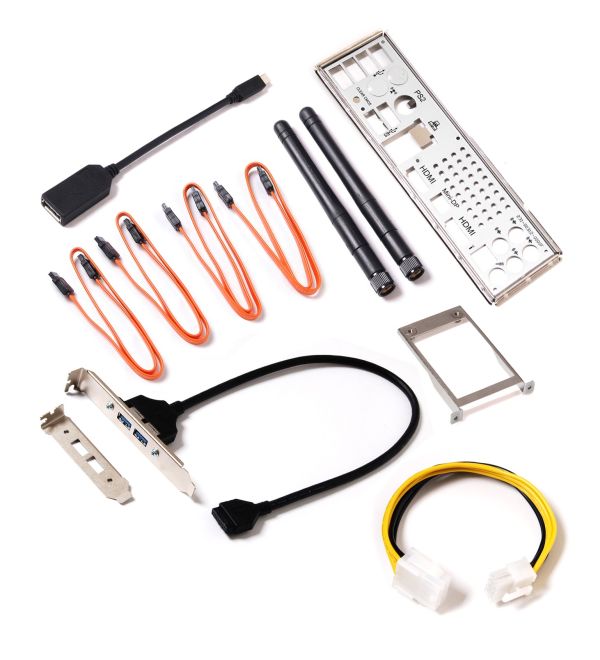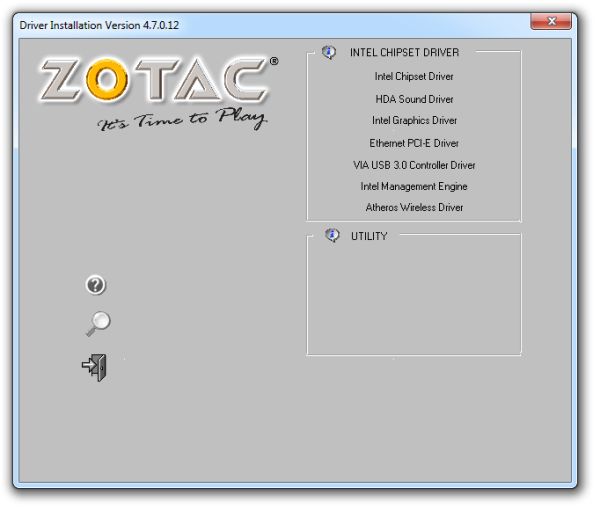Zotac Z68ITX-A-E Wifi Review - Mini-ITX meets Z68
by Ian Cutress on September 22, 2011 10:01 AM EST- Posted in
- Motherboards
- Mini ITX
- ZOTAC
- Z68
Board Features
| Zotac Z68ITX-A-E | |
| Market Segment | Small Form Factor |
| CPU Interface | LGA 1155 |
| CPU Support | i3/i5/i7 Sandy Bridge |
| Chipset | Z68 |
| Base Clock Frequency | 100 MHz by Default, 100 to 300 MHz in 0.01 MHz increments |
| DDR3 Memory Speed | 1333 MHz by Default, 1067 MHz to 2133 MHz supported |
| Core Voltage | 0 mV to +1020 mV offset |
| CPU Clock Multiplier | CPU Dependent |
| DRAM Voltage | -0.10 V to +0.16 V offset |
| DRAM Command Rate | N/A |
| Memory Slots |
Two DDR3-DIMM Maximum 8 GB, Non-ECC Unbuffered 1067, 1333, 1600, 1867 and 2133 MHz supported |
| Expansion Slots |
1 x PCIe x16 (x16/x16/x0 or x16/x8/x8) 1 x mini-PCIe/mSATA |
| Onboard SATA/RAID |
2 x SATA 6 Gbps (RAID 0, 1, 5, 0+1) 2 x SATA 3 Gbps (RAID 0, 1, 5, 0+1) |
| Onboard |
2 x SATA 6 Gbps 2 x SATA 3 Gbps 2 x Fan Headers 2 x USB 2.0 headers 1 x USB 3.0 header Power/Reset buttons Debug LED Front Panel Audio header SPDIF output header Front Panel header |
| Onboard LAN | Dual RealTek RTL8111E Gigabit Ethernet Controllers |
| Onboard Audio | Realtek ALC892 8-Ch High Definition audio CODEC |
| Power Connectors |
1 x 24-pin ATX 1 x 8-pin 12V |
| Fan Headers |
1 x CPU 1 x SYS |
| IO Panel |
2 x USB 3.0 Ports (VIA Controller) 4 x USB 2.0 Ports 1 x PS/2 Port 2 x Gigabit Ethernet 2 x Antenna 1 x Clear CMOS button 1 x Optical SPDIF output Audio Jacks 2 x HDMI 1.4a 1 x mini-DP |
| BIOS Version | 08/04/2011 |
| Warranty Period | 1 Year standard, 2 Year Extended (+3 if registered with Zotac) |
There are a couple of points we can tell where Zotac have tried to save money to keep the cost of the board down - the dual Realtek NIC and Audio controllers, and the VIA USB 3.0 controller support this idea. However, as mentioned previously, putting dual gigabit Ethernet, power/reset buttons, a debug LED and a mini-PCIe/mSATA on a mini-ITX is impressive for the price of this board.
In The Box
4 locking SATA cables
USB 3.0 Rear Bracket
I/O Shield
Two Antenna
8-pin 12V Power Extension cable
mSATA Stability Bracket
MiniDP to DP Video Adaptor
In a mini-ITX product, these are a lot of extras - particularly the 8-pin power extension cable (possibly to compensate for the position of the 8-pin 12V on the board) and the video adaptor, which by their presence would usually necessitate losing a SATA cable or two, or the USB 3.0 rear bracket, at the $170 product asking price.
Software
As we found out with our previous Zotac review, there isn't any extra software from Zotac for anyone to use - no overclocking or fan manipulation utilities for consumers. This is a double edged sword, as while there is no software to go wrong, it means consumers have to find other software to control their fans, etc.
In terms of the driver install, again Zotac software has no easy 'Install All' option - each one of the drivers must be installed manually and one-by-one, which is unfortunate when most of the other motherboard manufacturers have this utility.












29 Comments
View All Comments
dac7nco - Thursday, September 22, 2011 - link
I think at this point Zotac has proven that they either don't care about proper MB design, or they just don't care. ASRock has a cheap mITX Z68 board... what was the problem in reviewing that? The fact that a reputable place like Anandtech goes anywhere near Zotac's boards makes me wonder.Daimon
EnzoFX - Thursday, September 22, 2011 - link
I agree, Zotac boards are overrated and overpriced. They care more about how their specs look on paper. Not a brand I'd recommend or read about in a review =P, unless they seriously step things up in regards to their BIOS and reliability.Ananke - Thursday, September 22, 2011 - link
I completely understand that this is a great, feature full board. However, in my sole opinion, it is too expensive for the targeted market. Why would somebody use this plus at least a $100 processor for a HTPC, when the same can be done with $300-$400 budget laptop /which comes with the Win OS btw/, or less than $100 AMD E-350 setup?Good for the consumer, since it offers a choice. I guess the same type of people who buy BMW Mini - an expensive pretend-to-be sport car, would buy this too.
DaveSimmons - Thursday, September 22, 2011 - link
The target is a small-form-factor _gaming_ PC not a simple HTPC -- for a HTPC you don't need Z68 to allow overclocking am i5-2500K. For pure HTPC use a H61/H67 motherboard and possibly nothing more than a socket 1155 Pentium CPU is enough.I wouldn't buy one that always runs my CPU out of spec though.
Ananke - Thursday, September 22, 2011 - link
Dave, small form factor gaming PC is an oxymoron. Where are you going to put a high end GPU card on this board? Playing WoW on integrated graphics is not "gaming" for God's sake. Hence my thought, for $170 this board is worthless. It might be interesting if it costs $70 or less.Mr Perfect - Thursday, September 22, 2011 - link
People build plenty of small form factor gaming PCs. Get yourself a Silverstone Sugo 5 or 7 case and you can put any dual slot card you want in it.Breathless - Thursday, September 22, 2011 - link
You don't know what you are talking about. I have this very board in a Lian Li PC-Q08B with an Asus GTX 580 Direct CUii, 2600k, 8GB's of ram and several SSD's. It is fully acceptable to say I have a small form factor gaming PC.DaveSimmons - Thursday, September 22, 2011 - link
As they said, Silverstone and Lian-li both make SFF gaming cases for mini-ITX, and you can put a GTX 560 ti or AMD 6870 in all of them, or even a higher-end card in a couple of them.You can even buy prebuilt gaming systems from CyberPowerPC in the SG07 case (LAN Party EVO Mini).
Times change, your SFF knowledge is a little out of date.
Rick83 - Thursday, September 22, 2011 - link
Gigabyte has been doing something similar on their Cougar Point boards all summer (now the first BIOS versions fixing this are finally coming out)There, once you enabled XMP, the CPU was automatically overclocked and overvolted using, afaik, the same turbo-tweak as on this Zotac.
Not sure what they've been thinking.
TrackSmart - Thursday, September 22, 2011 - link
I understand the need to have comparable test conditions for testing the performance of motherboards. That being said, it would be interesting to many of us to see what you can realistically get away with (in terms of a gaming PC) using this form factor and a small form factor case to match... Running at stock speeds, when gaming, would a decent SFF case be able to keep up with the heat of a Z68 processor plus a mid-range GPU? What about an overclocked Z68 plus whatever the most powerful GPU that would fit the case? Is this a viable platform for that kind of computing power to begin with? If not, then the overclocking results aren't very relevant to your testing.Keep up the good work on the motherboard reviews. And if it seems feasible, maybe you could cover some of the questions above in a "SFF/Mini-ITX gaming system" article. The key question being whether a SFF gaming rig is an oxymoron.